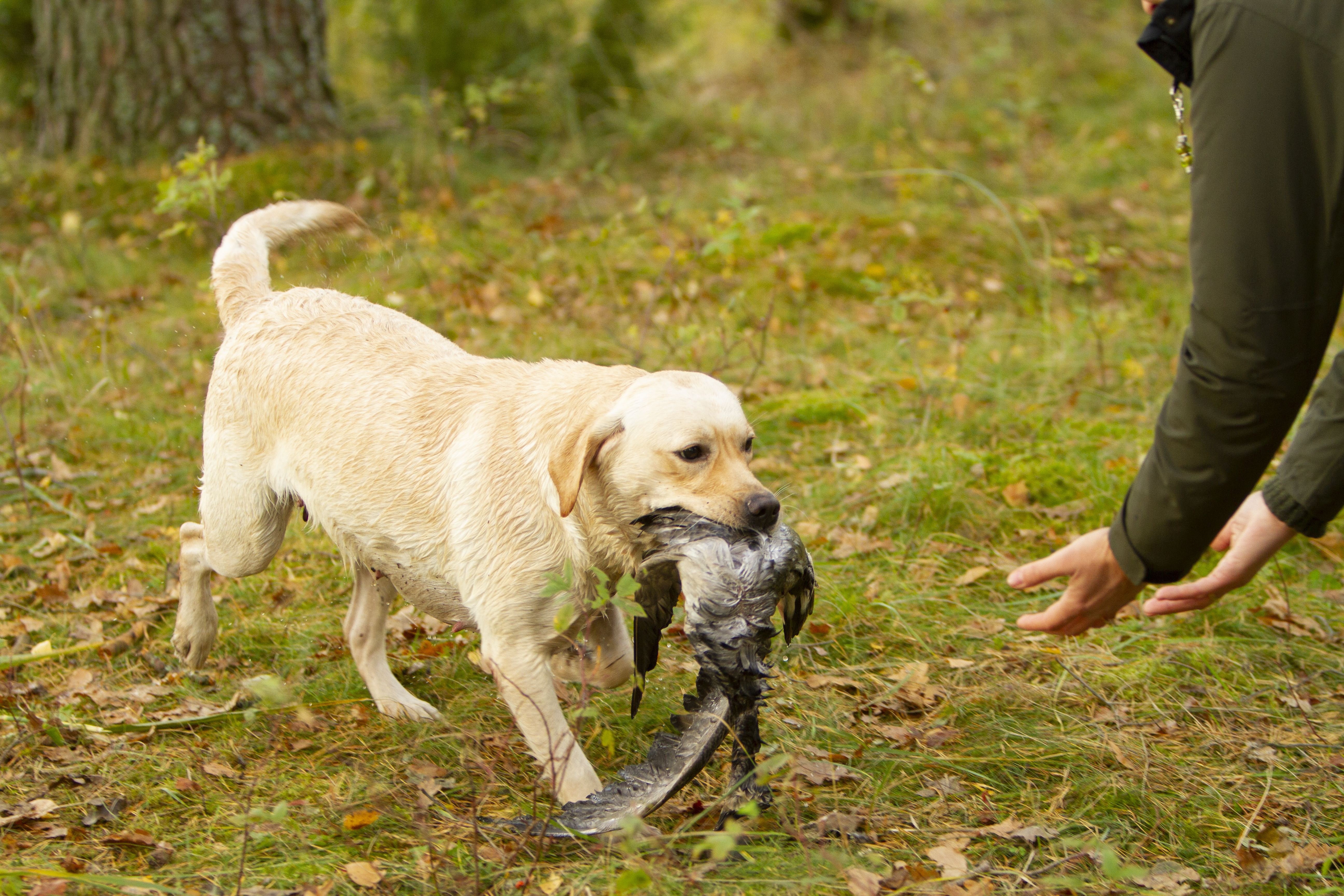RETRIEVER QUALIFICATION TEST
The Retriever Qualification Test is a test of breed-specific instincts, open to retriever breed dogs over 8 months old. The test aims to assess whether the dog’s temperament is characteristic of the specific retriever breed and whether the dog has the potential to be trained for retrieving small game and/or for retriever hunting tests. Evaluating breed-specific instincts also helps assess the dog’s breeding value.
The retriever qualification test can be completed using either game or dummies. In the game test, ducks are used in water work, pheasants or crows on land, and rabbits on a track. In the dummy test, special textile retrieving objects, known as dummies, are used.

A dog that passes the test with game can apply for an international FCI working certificate, allowing the dog to be registered in the working class at all shows and enabling the confirmation of national and international conformation champion titles. A dog that passes the test with a dummy can apply for a national working certificate, allowing the dog to be registered in the working class at national, group, and specialty shows and enabling the confirmation of only the EST V CH title.
Training and participating in retriever tests provides the opportunity to offer the dog work that aligns with its breed characteristics. Many dogs enjoy doing what they were bred for. Breed-specific tests help keep your dog active, engaged, and ready to cooperate. Training enhances mutual understanding between the dog and handler and teaches the dog to control its impulses and cooperate with the handler. Although this is an instinct test for retrievers, it is advisable to prepare the dog for the qualification test. Basic obedience is necessary—the dog should come when called and be willing to relinquish objects to the handler.

The retriever qualification test consists of four parts: social behavior assessment, water work, search, and tracking. The test evaluates the dog’s social behavior, willingness to swim, retrieving desire, search drive, game grip, willingness to retrieve and delivery of the game, reaction to gunfire, tracking work, and cooperation with the handler.
Photo: Natālija Klane
1. Social Behavior
The judge gathers the handlers and dogs in a group with a few meters between each. The judge introduces the test and shakes hands with each participant, expecting the dogs to exhibit social and friendly behavior. Afterward, the first dog starts the water work, while the other dogs wait in cars or the designated waiting area until it is their turn. Each dog performs the test out of sight of the others.

2. Water Work
Two birds are thrown into the water for the dog. The judge throws the first bird into shallow water to see if the dog willingly enters the water and is interested in retrieving the bird. If successful, a second bird is thrown from a boat about 20 meters from the shore. Before the second throw, a gunshot is fired, with the shooter clearly visible to the dog but not too close. The dog should retrieve the birds at least to the shore, ideally bringing them directly to the handler.

3. Search
After completing the water work, the dog continues with the search task. Five birds are placed on the terrain, the farthest at least 50 meters away. The dog, on a leash beside the handler, hears a gunshot as the sixth bird is thrown in such a way that the dog sees the throw but may not see the landing spot. The assistants and shooter then leave the area, and the judge gives the signal for the dog to start retrieving the birds. The dog must retrieve enough birds to demonstrate that its search drive does not wane. The dog should have enough confidence to find and retrieve the farthest bird and should bring the birds close to the handler, preferably directly to hand.

4. Tracking
After retrieving, the judge verbally evaluates the dog’s work and announces whether the dog is allowed to proceed to the tracking phase. To advance to tracking, the dog must have successfully completed all previous tasks. The track is made with a rabbit after all dogs have completed the water work and search in turn. The track is about 80 meters long and follows the natural variations of the terrain. While one dog is tracking, the other dogs must remain hidden. The dog must find the rabbit on its own and bring it to the handler.

To pass the test, the dog must achieve a result of “completed” in all assessed traits. The judge may repeat tasks to confirm the dog’s instincts and assist the dog if needed. The test will be stopped if the dog shows a complete lack of work drive, is strongly gun-shy, damages or throws the game, refuses to enter the water, is aggressive toward other dogs or people, barks or whines so disruptively that the test cannot continue, loses control, or if the cooperation between dog and handler is so poor that the test cannot be completed.
A dog that successfully passes the qualification test receives a diploma, which can be used to apply for an international working certificate from the Estonian Kennel Union.
Rules for the different retriever tests can be found on the Estonian Kennel Union Retriever Association’s website.
